
Jupiter in Your Horoscope
Jovial, Expansion and Preservation
Material Matters of all Kind
In an individual's astrological birth chart the placement of Jupiter is thought to signify progression and preservation. Jupiter has a twelve year cycle and so passes through each zodiac sign once during the period of its rotation. It's position in a natal plotting can help determine a person's possibilities for advancement in life. Jupiter's coordinates here will also assist in uncovering someone's ability or inability to preserve their energies by pacing themselves. Simply put Jupiter stands for steady and progressive growth wherever it puts in an appearance. In some areas of a horoscope review this signal of expansion proves very useful to pinpoint future potential.
Jupiter is the largest planet in our Solar System and it is the fifth closest in distance to our Sun. Its atmosphere is made up of Hydrogen and Helium and it is surrounded and covered by clouds of ammonia crystals. Jupiter is a giant gas spheroid and it has a slight bulge around its center and a just visible ring of cosmic dust around it. This is an impressive planet dedicated to Jupiter who was known as the King of the Gods by many ancient cultures and so considered extremely influential. This planet's influence brings with it strength of body and mind, motivation, intelligence and confidence. Leadership and communication qualities are also part of Jupiter's possible gifts upon human personalities.
The majority of mythical history concerning Jupiter originates from the earliest people of Greek and Roman times. Within Grecian mythology the God Zeus was regarded as a mighty protector of Man and it was believed that he brought order and peace. He had many names connected to weather conditions including the Rain God and the cloud chaser. The Romans renamed Zeus as Jupiter and adopted him as their top guardian, whom they could trust to protect and guide them. Jupiter is said to have overthrown the God Saturn to take his place as the most powerful God in existence. Without some of Jupiter's contribution of forceful betterment personalities are likely to be less enthusiastic and driven.
The Romans imagined the God Jupiter to own an eagle that he employed to deliver his messages to others. This effective form of communicating to convey your thoughts and instructions is seen in a Jupiter influenced horoscope interpretation. Jupiter's main weapon in the descriptions of centuries old historical texts was his talent to produce thunder and lightening in the sky. This must have been rather frightening for people and was taken as a display of this God's anger. This may be an explanation for the connection between the amount of respect Jupiter commanded and the strong belief in his power. In Astrology and for personality prediction use it indicates a durable and firm force at work.
While viewing the rest of the planetary alignment in a natal horoscope study it is certainly worth looking for and at Jupiter's location. Its lining up with the other planets and stars will help identify and highlight significant characteristics of a personality. This is helpful to attempt to discover the inner workings of a person's mind and an idea of their intellectual curiosities. Jupiter positions can give little clues to an individual's personal temperament and sometimes even how materialistic they are. These positioned points can induce inspiration and prosperity into any aspect of a person's character and destined path. When looked at singly these locations may not mean much but when inspected with the other birth time points they add much to a date and time of birth reading.
In Astrology Jupiter is represented by a symbol with the joint formation of a crescent and a cross. This icon is thought to symbolize the thunderbolt or the eagle of the legendary God Jupiter. Its unusual shape makes it recognizable from the other symbols with its strange upward curve. The left sided curved is assumed to signify the mind rising above the matter symbolized by the cross. This composition makes it easy to remember the moving forward and growing message of Jupiter's influence. His presence will imply someone's inclinations to want to do well in life and better themselves physically. emotionally or intellectually. It will show their apptitude for learning and their will to persevere.
Jupiter is ruled by the Sun sign of Sagittarius according to Western Astrology adding luck and opportunity to its list of influences. If Jupiter is quite prominent in your horoscope assessment then it is a suggestion that you will probably be a seemingly naturally lucky person. There is also a jovial element in association with Jupiter's appearance and this can be seen quite often in people's charts. This is possibly connected to the enthusiasm, development and progression of Jupiter's most dominant authorities and his motivating inspirational forces. There are many discoveries to be made on individual birth maps by analyzing the effect of Jupiter wherever it shows up.
Planet Profile
Mass (kg) 1.90 x 1027
Diameter (km) 142,800
Mean density (kg/m3) 1314
Escape velocity (m/s) 59500
Average distance from Sun 5.203 AU (778,412,020 km)
Rotation period (length of day in Earth days) 0.41 (9.8 Earth hours)
Revolution period (length of year in Earth years) 11.86
Obliquity (tilt of axis degrees) 3.08
Orbit inclination (degrees) 1.3
Orbit eccentricity (deviation from circular) 0.048
Mean surface temperature (K) 120 (cloud tops)
Visual geometric albedo (reflectivity) 0.44
Atmospheric components
90% hydrogen,
10% helium,
.07% methane
Rings
Faint ring.
Infrared spectra imply dark rock fragments.
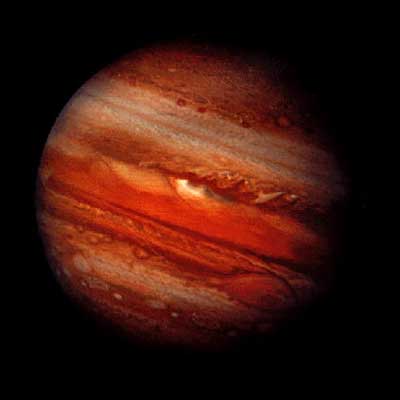 Full Disk
Full Disk
Jupiter is a "gas giant"; all gas giants are similar to Jupiter in composition. Jupiter's diameter is 11 times Earth's diameter and 20% larger than Saturn's, making it the largest planet in the solar system. Gas giant are also very much larger than terrestrial planets. This color-enhanced image of Jupiter was taken by Voyager 1.
Jovian System
Voyager 1 took this photo of Jupiter and two of its satellites, Io on the left and Europa on the right. Io is about 350,000 km (217,000 mi) above Jupiter's Great Red Spot; Europa is about 600,000 km (372,000 mi) above Jupiter's clouds. Although both satellites have about the same brightness, Io's color is different from Europa's. Io's equatorial region shows two shades of red, possibly indicating different surface materials.
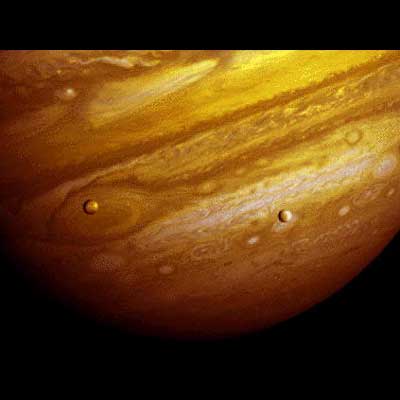
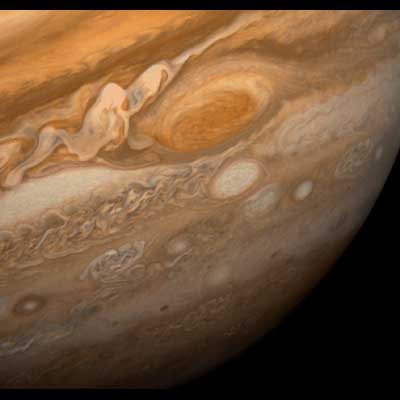 The Great Red Spot
The Great Red Spot
The colorful, wavy cloud pattern to the left of the Red Spot is a region of extraordinarily complex wave motion. This dramatic view of the Great Red Spot and its surroundings was taken February 25, 1979, when Voyager 1 was 9.2 million km (5.7 million mi) from Jupiter. An atmospheric system larger than Earth and more than 300 years old, the Great Red Spot remains a mystery. Swirling, storm-like features possibly associated with wind shear can be seen both to the left and above the Red Spot.
White Cloud
This mosaic of the Great Red Spot was taken by the Voyager 2 spacecraft. It shows that the region changed significantly since the Voyager 1 encounter four months earlier. Around the northern boundary a white cloud is seen, which extends east of the region. The presence of this cloud prevents small cloud vertices from circling the spot in the manner seen in the Voyager 1 encounter.
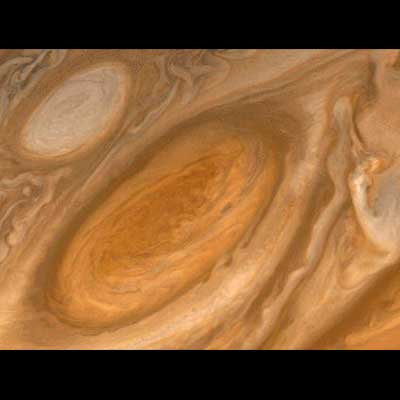
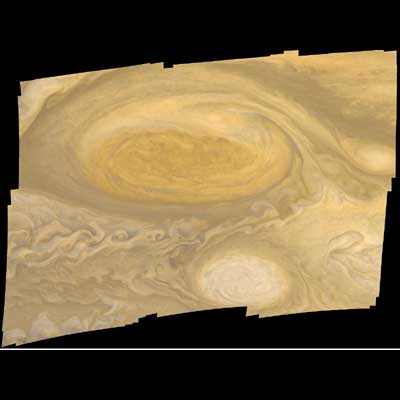 Red Spot Turbulence
Red Spot Turbulence
The turbulence surrounding the Great Red Spot is shown here in enhanced color, which tends to emphasize red and blue at the expense of green. Near the bottom you can see one of three oval cloud systems that formed nearly 40 years ago. The distance from top to bottom of this picture is 24,000 km (15,000 mi).
Water Cloud Thunderstorm
A convective thunderstorm is the northwest of Jupiter's Great Red Spot. The white area in the center is a tall, thick cloud higher than most of the surrounding clouds. Most of the wisps and features are thick and thin ammonia clouds, forming at a pressure just less than Earth's sea level pressure. The red base of this thunderstorm is a water cloud. The blue and green areas depict higher clouds, while the red areas show deep clouds as well as those higher in the atmosphere.
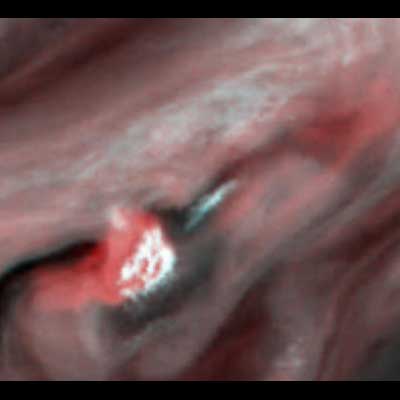
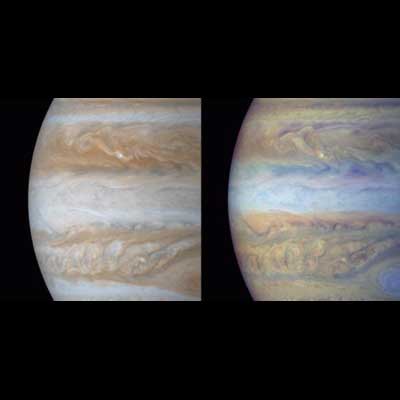 Jupiter in True and False Color
Jupiter in True and False Color
These color composite frames of the mid-section of Jupiter were acquired by the Cassini spacecraft on December 31, 2000. The frame on the left is a natural color composite yielding the color that Jupiter would have if seen by the naked eye. The right frame is composed of three images: two were taken through narrow band filters centered on regions of the spectrum where the gaseous methane in Jupiter's atmosphere absorbs light, and the third was taken in a red continuum region of the spectrum, where Jupiter has no absorptions. From images like these, the stratigraphy of Jupiter's dynamic atmosphere will be determined.
Large Brown Oval
This large brown oval could be an opening in the upper cloud deck where warmer cloud levels may exist. Features of this sort are not rare on Jupiter and have an average lifetime of one to two years. Above the feature is the pale orange North Temperate Belt, bounded on the south by the high-speed North Temperate Current with winds of 120 m/s (260 mi/hr). The range to Jupiter, on March 2, 1979 when this photograph was taken, was 4.0 million km (2.5 million mi).
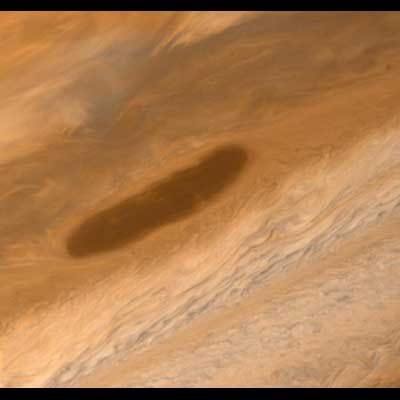
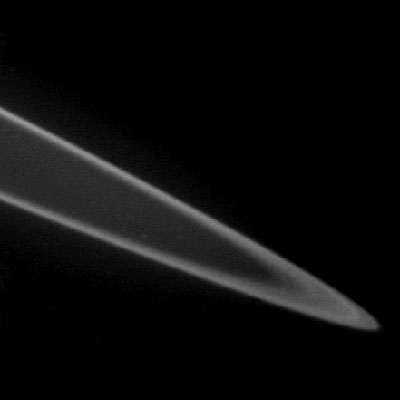 Ring System
Ring System
Data from the Pioneer 10 and 11 spacecraft suggested that a ring system around the giant planet Jupiter existed; this was confirmed by the Voyager flybys. This image was taken by Voyager 2 looking back at the rings from inside Jupiter's shadow. The ring is very bright because it is composed of fine dust, which scatters light efficiently in this viewing geometry. The picture shows the main ring 7000 km (4350 mi) wide, with a broad, thick "halo" inside it.
Ring System Mosaic
The Galileo spacecraft acquired the top mosaic of Jupiter's ring system when the spacecraft was in Jupiter's shadow looking back toward the Sun. Jupiter's ring system (the inset diagram) is composed of three parts: an outermost gossamer ring, a flat main ring, and an innermost donut-shaped halo. These rings are made up of dust-sized particles that are blasted off of the nearby inner satellites by small impacts. This image was taken on November 9, 1996 at a distance of 2.3 million kilometers (1.4 million miles).
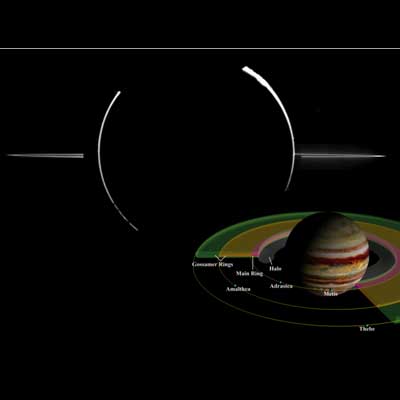
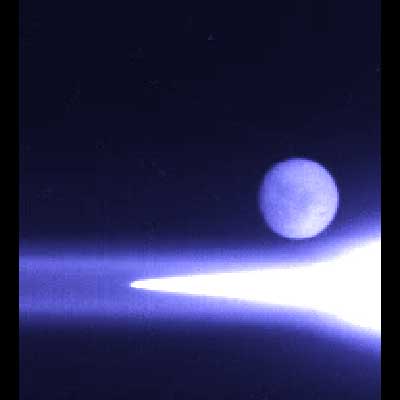 Europa above the Jovian Ring
Europa above the Jovian Ring
This image taken by the Galileo spacecraft shows the dark side of the moon Europa, lit exclusively by light scattered back from Jupiter. The ring system, nearly edge-on, was captured as well. The image has been enhanced in false color to show structures more clearly. The tip of the main ring is in white and expands into the halo near the right edge. The faint stripe of blue extending outward from the tip is part of the gossamer ring, a cloud of dust ejected from the moons Amalthea and Thebe.
Global Mosaic
Io's surface materials are rich in sulfur compounds. Its volcanism is driven by tidal stresses induced by Jupiter and the next satellite out, Europa. Black lava lakes dot Io's surface, some of them as hot as 200 deg.C (392 deg.F). Io measures 3630 km (2178 mi) in diameter.
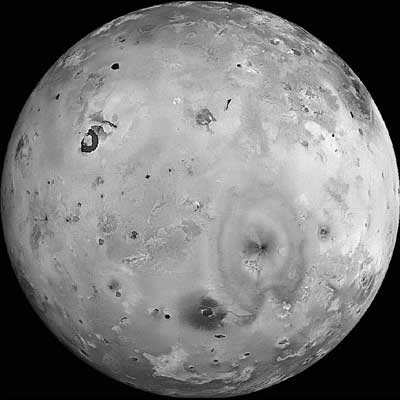
In mythology :
Jupiter was the supreme god of the Romans
, and the Lord of the Heavens and the Sky.
Being the lord of the skies he was responsible for all the weather, especially thunder and lightning, he was sometimes referred to as the Thunderer for this reason.
At first Jupiter may have been seen as an agricultural god. As time passed and the Romans became more civilised, he developed and became the god of all human endeavours.
As the greatest of the gods he was also seen as a great champion, and was invoked for victory in all things, especially battle.
Jupiter gave birth to the goddess Minerva from the top of his head, it was Juno's (Jupiter's wife) jealousy of this event that was the main reason for the birth of Mars. Mars was born with no input (so to speak) from Jupiter, and was soon to rival Jupiter as the god of war.
He was invoked for luck, wealth, victory, good weather and most human affairs.
Comments: Jupiter Meaning - the Luckiest Star